Team Management and Leadership in Police Organizations
VerifiedAdded on 2023/05/30
|12
|2395
|431
Report
AI Summary
This report provides an overview of team management and leadership principles, focusing on their application within organizations, particularly in law enforcement. It addresses key questions related to planning, organizing, leadership consent, and control functions. The report analyzes the evolution of policing strategies, emphasizing the importance of stakeholder involvement and community engagement. It assesses the New South Wales Police Force's authority system, objectives, and information systems, suggesting improvements such as technological enhancements and departmental restructuring. Furthermore, it highlights the critical role of middle managers, the application of Fayol's and Drucker's principles, and the significance of understanding organizational behavior to enhance team performance. The report concludes with reflections on supervisory skills, employee understanding, and strategies for addressing challenges in implementing new goals.
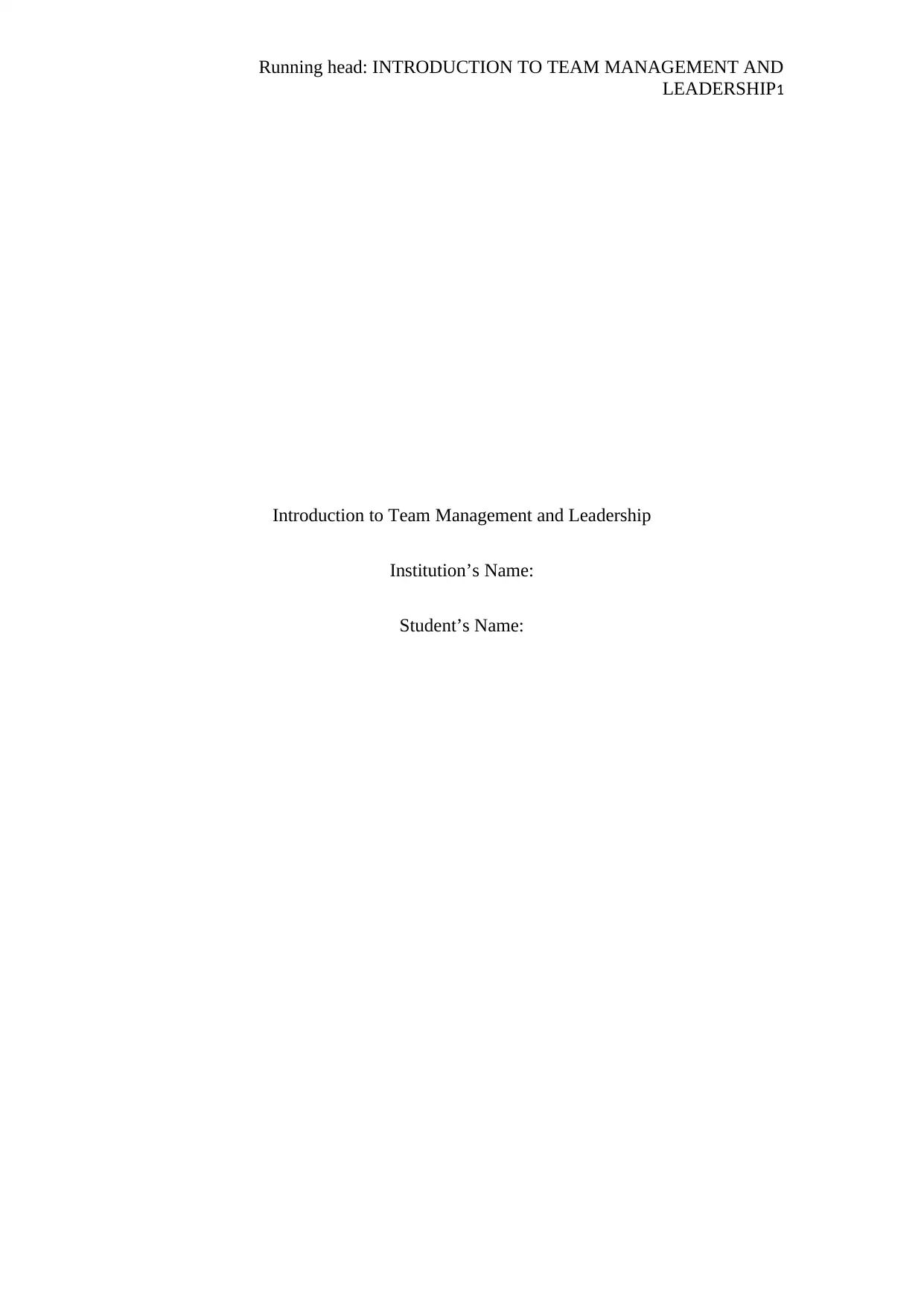
Running head: INTRODUCTION TO TEAM MANAGEMENT AND
LEADERSHIP1
Introduction to Team Management and Leadership
Institution’s Name:
Student’s Name:
LEADERSHIP1
Introduction to Team Management and Leadership
Institution’s Name:
Student’s Name:
Paraphrase This Document
Need a fresh take? Get an instant paraphrase of this document with our AI Paraphraser
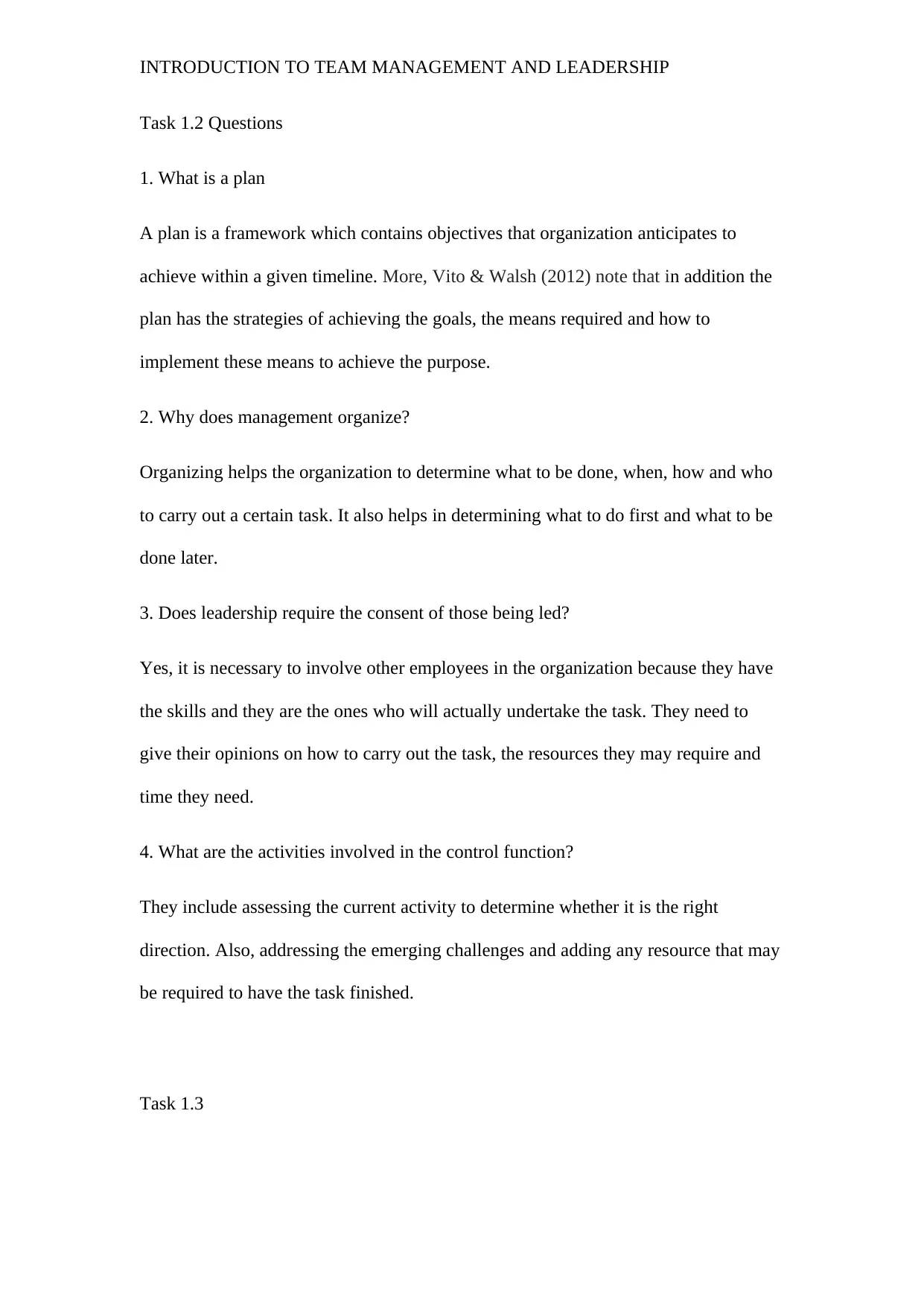
INTRODUCTION TO TEAM MANAGEMENT AND LEADERSHIP
Task 1.2 Questions
1. What is a plan
A plan is a framework which contains objectives that organization anticipates to
achieve within a given timeline. More, Vito & Walsh (2012) note that in addition the
plan has the strategies of achieving the goals, the means required and how to
implement these means to achieve the purpose.
2. Why does management organize?
Organizing helps the organization to determine what to be done, when, how and who
to carry out a certain task. It also helps in determining what to do first and what to be
done later.
3. Does leadership require the consent of those being led?
Yes, it is necessary to involve other employees in the organization because they have
the skills and they are the ones who will actually undertake the task. They need to
give their opinions on how to carry out the task, the resources they may require and
time they need.
4. What are the activities involved in the control function?
They include assessing the current activity to determine whether it is the right
direction. Also, addressing the emerging challenges and adding any resource that may
be required to have the task finished.
Task 1.3
Task 1.2 Questions
1. What is a plan
A plan is a framework which contains objectives that organization anticipates to
achieve within a given timeline. More, Vito & Walsh (2012) note that in addition the
plan has the strategies of achieving the goals, the means required and how to
implement these means to achieve the purpose.
2. Why does management organize?
Organizing helps the organization to determine what to be done, when, how and who
to carry out a certain task. It also helps in determining what to do first and what to be
done later.
3. Does leadership require the consent of those being led?
Yes, it is necessary to involve other employees in the organization because they have
the skills and they are the ones who will actually undertake the task. They need to
give their opinions on how to carry out the task, the resources they may require and
time they need.
4. What are the activities involved in the control function?
They include assessing the current activity to determine whether it is the right
direction. Also, addressing the emerging challenges and adding any resource that may
be required to have the task finished.
Task 1.3
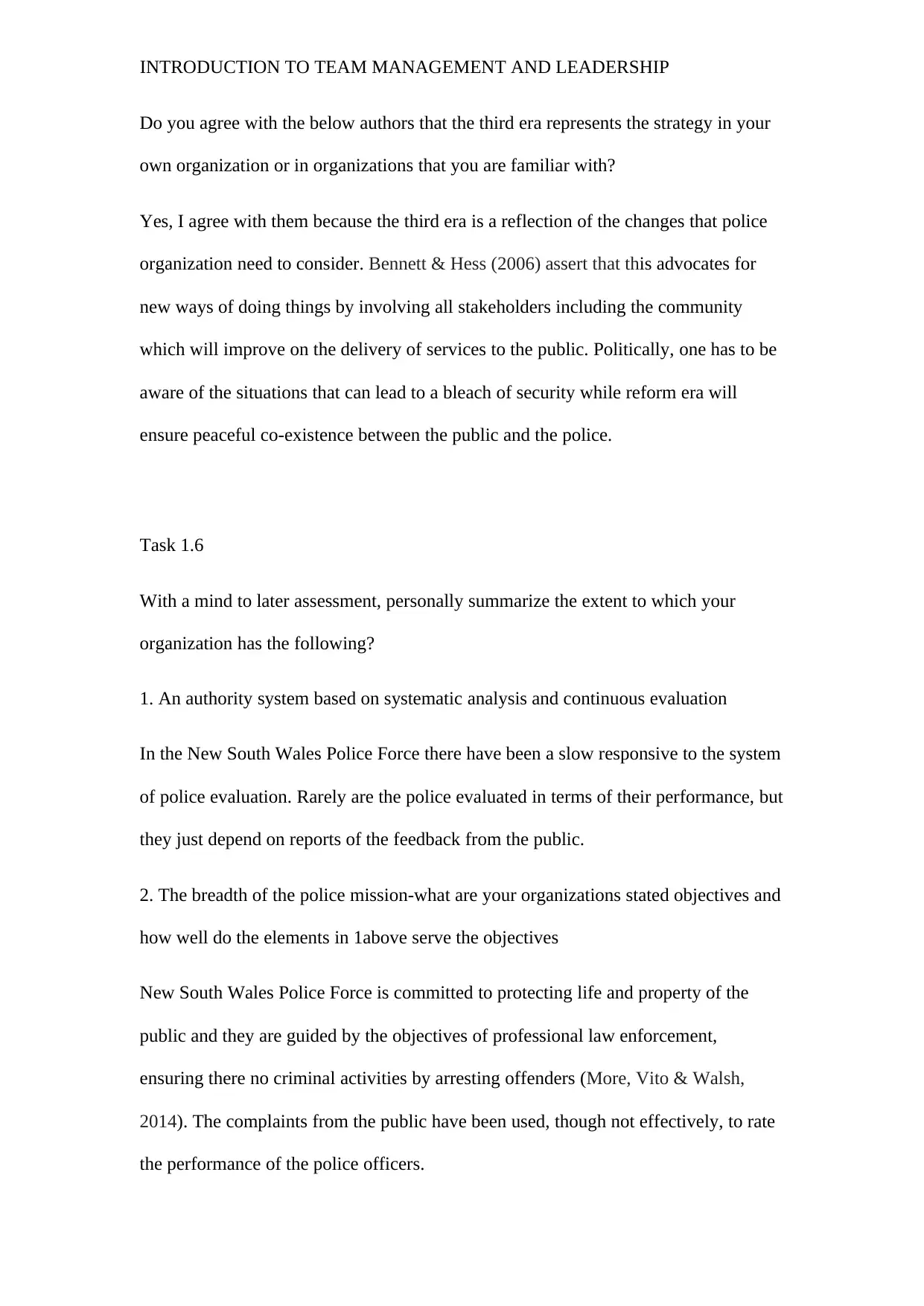
INTRODUCTION TO TEAM MANAGEMENT AND LEADERSHIP
Do you agree with the below authors that the third era represents the strategy in your
own organization or in organizations that you are familiar with?
Yes, I agree with them because the third era is a reflection of the changes that police
organization need to consider. Bennett & Hess (2006) assert that this advocates for
new ways of doing things by involving all stakeholders including the community
which will improve on the delivery of services to the public. Politically, one has to be
aware of the situations that can lead to a bleach of security while reform era will
ensure peaceful co-existence between the public and the police.
Task 1.6
With a mind to later assessment, personally summarize the extent to which your
organization has the following?
1. An authority system based on systematic analysis and continuous evaluation
In the New South Wales Police Force there have been a slow responsive to the system
of police evaluation. Rarely are the police evaluated in terms of their performance, but
they just depend on reports of the feedback from the public.
2. The breadth of the police mission-what are your organizations stated objectives and
how well do the elements in 1above serve the objectives
New South Wales Police Force is committed to protecting life and property of the
public and they are guided by the objectives of professional law enforcement,
ensuring there no criminal activities by arresting offenders (More, Vito & Walsh,
2014). The complaints from the public have been used, though not effectively, to rate
the performance of the police officers.
Do you agree with the below authors that the third era represents the strategy in your
own organization or in organizations that you are familiar with?
Yes, I agree with them because the third era is a reflection of the changes that police
organization need to consider. Bennett & Hess (2006) assert that this advocates for
new ways of doing things by involving all stakeholders including the community
which will improve on the delivery of services to the public. Politically, one has to be
aware of the situations that can lead to a bleach of security while reform era will
ensure peaceful co-existence between the public and the police.
Task 1.6
With a mind to later assessment, personally summarize the extent to which your
organization has the following?
1. An authority system based on systematic analysis and continuous evaluation
In the New South Wales Police Force there have been a slow responsive to the system
of police evaluation. Rarely are the police evaluated in terms of their performance, but
they just depend on reports of the feedback from the public.
2. The breadth of the police mission-what are your organizations stated objectives and
how well do the elements in 1above serve the objectives
New South Wales Police Force is committed to protecting life and property of the
public and they are guided by the objectives of professional law enforcement,
ensuring there no criminal activities by arresting offenders (More, Vito & Walsh,
2014). The complaints from the public have been used, though not effectively, to rate
the performance of the police officers.
⊘ This is a preview!⊘
Do you want full access?
Subscribe today to unlock all pages.

Trusted by 1+ million students worldwide
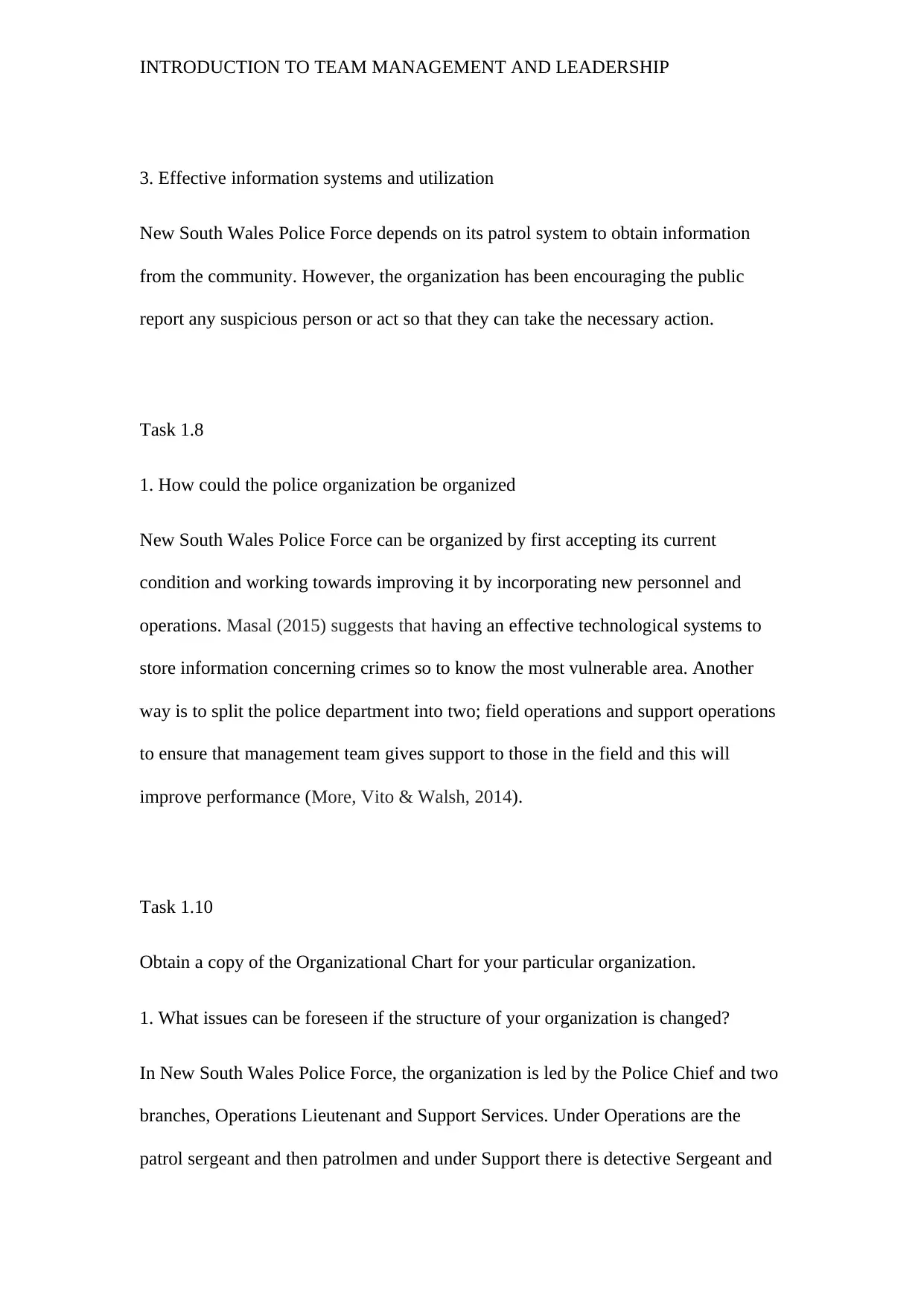
INTRODUCTION TO TEAM MANAGEMENT AND LEADERSHIP
3. Effective information systems and utilization
New South Wales Police Force depends on its patrol system to obtain information
from the community. However, the organization has been encouraging the public
report any suspicious person or act so that they can take the necessary action.
Task 1.8
1. How could the police organization be organized
New South Wales Police Force can be organized by first accepting its current
condition and working towards improving it by incorporating new personnel and
operations. Masal (2015) suggests that having an effective technological systems to
store information concerning crimes so to know the most vulnerable area. Another
way is to split the police department into two; field operations and support operations
to ensure that management team gives support to those in the field and this will
improve performance (More, Vito & Walsh, 2014).
Task 1.10
Obtain a copy of the Organizational Chart for your particular organization.
1. What issues can be foreseen if the structure of your organization is changed?
In New South Wales Police Force, the organization is led by the Police Chief and two
branches, Operations Lieutenant and Support Services. Under Operations are the
patrol sergeant and then patrolmen and under Support there is detective Sergeant and
3. Effective information systems and utilization
New South Wales Police Force depends on its patrol system to obtain information
from the community. However, the organization has been encouraging the public
report any suspicious person or act so that they can take the necessary action.
Task 1.8
1. How could the police organization be organized
New South Wales Police Force can be organized by first accepting its current
condition and working towards improving it by incorporating new personnel and
operations. Masal (2015) suggests that having an effective technological systems to
store information concerning crimes so to know the most vulnerable area. Another
way is to split the police department into two; field operations and support operations
to ensure that management team gives support to those in the field and this will
improve performance (More, Vito & Walsh, 2014).
Task 1.10
Obtain a copy of the Organizational Chart for your particular organization.
1. What issues can be foreseen if the structure of your organization is changed?
In New South Wales Police Force, the organization is led by the Police Chief and two
branches, Operations Lieutenant and Support Services. Under Operations are the
patrol sergeant and then patrolmen and under Support there is detective Sergeant and
Paraphrase This Document
Need a fresh take? Get an instant paraphrase of this document with our AI Paraphraser
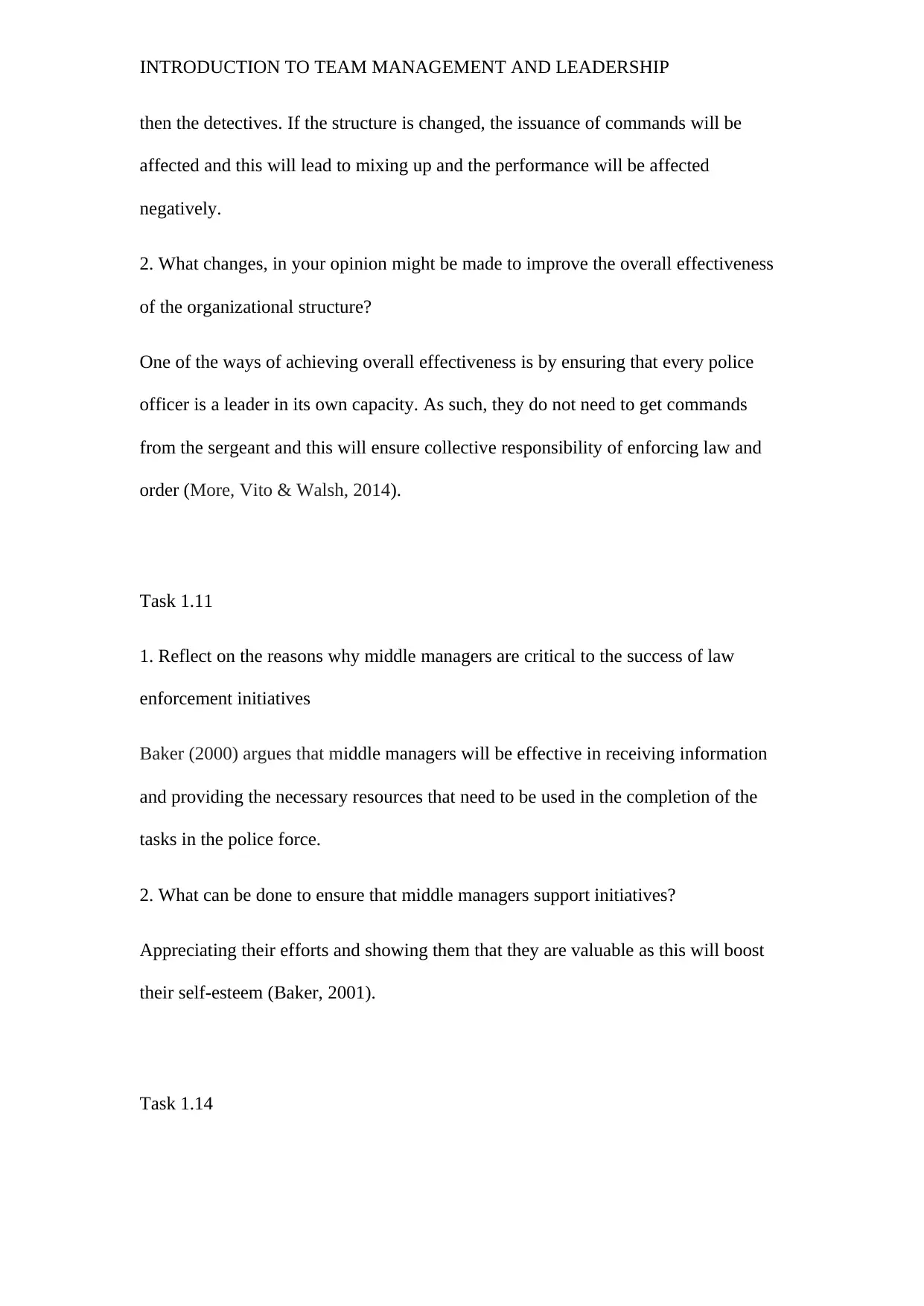
INTRODUCTION TO TEAM MANAGEMENT AND LEADERSHIP
then the detectives. If the structure is changed, the issuance of commands will be
affected and this will lead to mixing up and the performance will be affected
negatively.
2. What changes, in your opinion might be made to improve the overall effectiveness
of the organizational structure?
One of the ways of achieving overall effectiveness is by ensuring that every police
officer is a leader in its own capacity. As such, they do not need to get commands
from the sergeant and this will ensure collective responsibility of enforcing law and
order (More, Vito & Walsh, 2014).
Task 1.11
1. Reflect on the reasons why middle managers are critical to the success of law
enforcement initiatives
Baker (2000) argues that middle managers will be effective in receiving information
and providing the necessary resources that need to be used in the completion of the
tasks in the police force.
2. What can be done to ensure that middle managers support initiatives?
Appreciating their efforts and showing them that they are valuable as this will boost
their self-esteem (Baker, 2001).
Task 1.14
then the detectives. If the structure is changed, the issuance of commands will be
affected and this will lead to mixing up and the performance will be affected
negatively.
2. What changes, in your opinion might be made to improve the overall effectiveness
of the organizational structure?
One of the ways of achieving overall effectiveness is by ensuring that every police
officer is a leader in its own capacity. As such, they do not need to get commands
from the sergeant and this will ensure collective responsibility of enforcing law and
order (More, Vito & Walsh, 2014).
Task 1.11
1. Reflect on the reasons why middle managers are critical to the success of law
enforcement initiatives
Baker (2000) argues that middle managers will be effective in receiving information
and providing the necessary resources that need to be used in the completion of the
tasks in the police force.
2. What can be done to ensure that middle managers support initiatives?
Appreciating their efforts and showing them that they are valuable as this will boost
their self-esteem (Baker, 2001).
Task 1.14
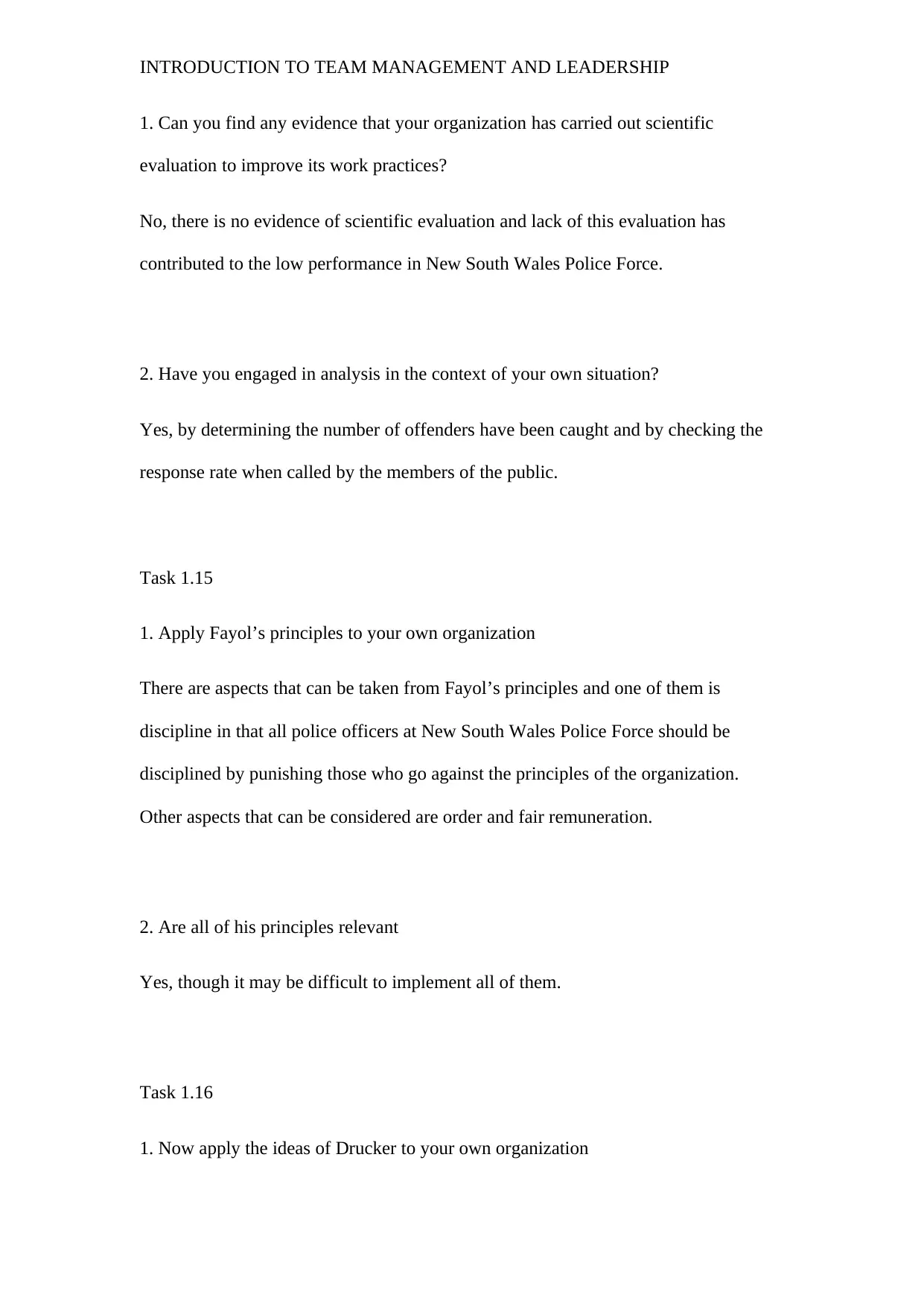
INTRODUCTION TO TEAM MANAGEMENT AND LEADERSHIP
1. Can you find any evidence that your organization has carried out scientific
evaluation to improve its work practices?
No, there is no evidence of scientific evaluation and lack of this evaluation has
contributed to the low performance in New South Wales Police Force.
2. Have you engaged in analysis in the context of your own situation?
Yes, by determining the number of offenders have been caught and by checking the
response rate when called by the members of the public.
Task 1.15
1. Apply Fayol’s principles to your own organization
There are aspects that can be taken from Fayol’s principles and one of them is
discipline in that all police officers at New South Wales Police Force should be
disciplined by punishing those who go against the principles of the organization.
Other aspects that can be considered are order and fair remuneration.
2. Are all of his principles relevant
Yes, though it may be difficult to implement all of them.
Task 1.16
1. Now apply the ideas of Drucker to your own organization
1. Can you find any evidence that your organization has carried out scientific
evaluation to improve its work practices?
No, there is no evidence of scientific evaluation and lack of this evaluation has
contributed to the low performance in New South Wales Police Force.
2. Have you engaged in analysis in the context of your own situation?
Yes, by determining the number of offenders have been caught and by checking the
response rate when called by the members of the public.
Task 1.15
1. Apply Fayol’s principles to your own organization
There are aspects that can be taken from Fayol’s principles and one of them is
discipline in that all police officers at New South Wales Police Force should be
disciplined by punishing those who go against the principles of the organization.
Other aspects that can be considered are order and fair remuneration.
2. Are all of his principles relevant
Yes, though it may be difficult to implement all of them.
Task 1.16
1. Now apply the ideas of Drucker to your own organization
⊘ This is a preview!⊘
Do you want full access?
Subscribe today to unlock all pages.

Trusted by 1+ million students worldwide
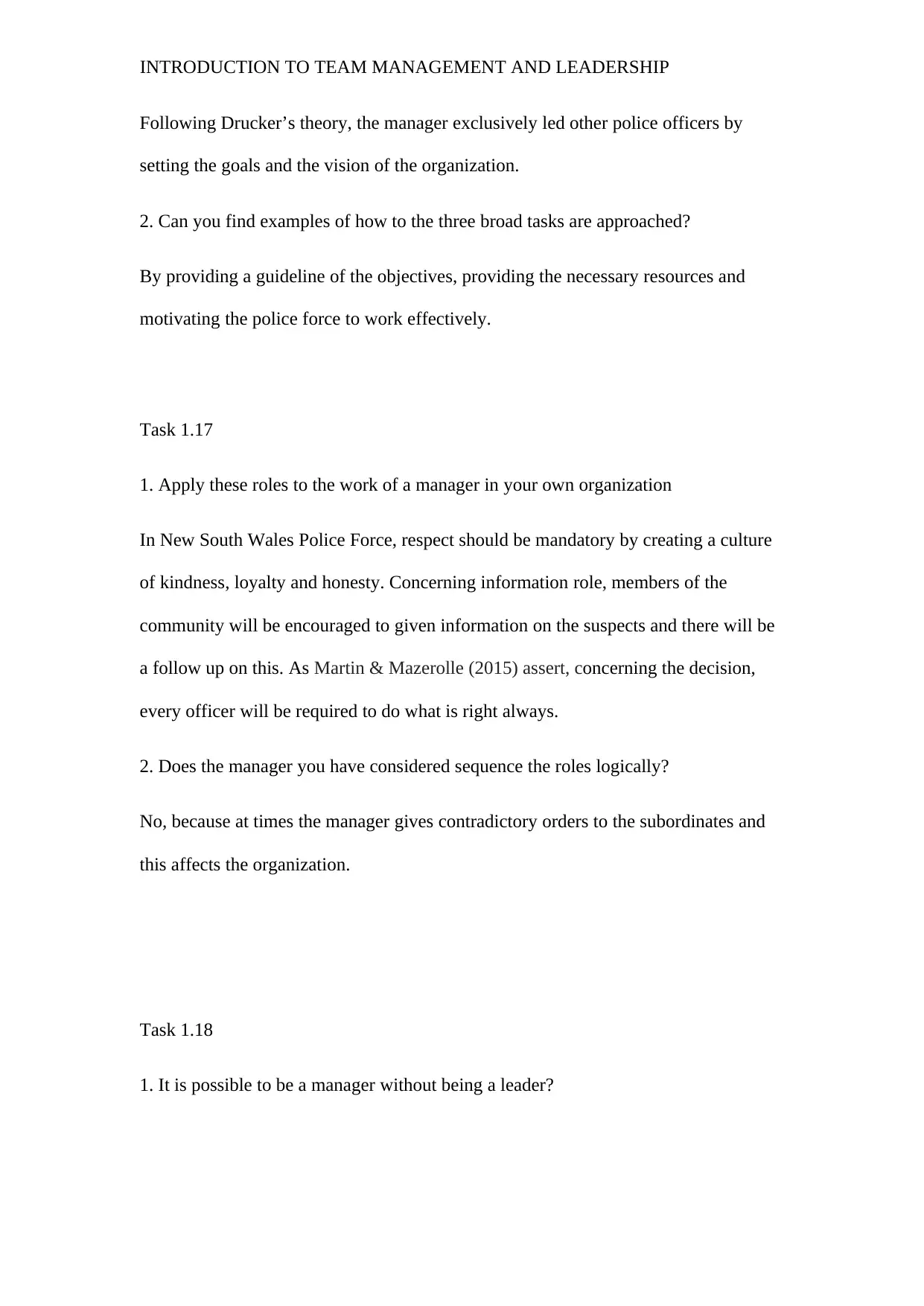
INTRODUCTION TO TEAM MANAGEMENT AND LEADERSHIP
Following Drucker’s theory, the manager exclusively led other police officers by
setting the goals and the vision of the organization.
2. Can you find examples of how to the three broad tasks are approached?
By providing a guideline of the objectives, providing the necessary resources and
motivating the police force to work effectively.
Task 1.17
1. Apply these roles to the work of a manager in your own organization
In New South Wales Police Force, respect should be mandatory by creating a culture
of kindness, loyalty and honesty. Concerning information role, members of the
community will be encouraged to given information on the suspects and there will be
a follow up on this. As Martin & Mazerolle (2015) assert, concerning the decision,
every officer will be required to do what is right always.
2. Does the manager you have considered sequence the roles logically?
No, because at times the manager gives contradictory orders to the subordinates and
this affects the organization.
Task 1.18
1. It is possible to be a manager without being a leader?
Following Drucker’s theory, the manager exclusively led other police officers by
setting the goals and the vision of the organization.
2. Can you find examples of how to the three broad tasks are approached?
By providing a guideline of the objectives, providing the necessary resources and
motivating the police force to work effectively.
Task 1.17
1. Apply these roles to the work of a manager in your own organization
In New South Wales Police Force, respect should be mandatory by creating a culture
of kindness, loyalty and honesty. Concerning information role, members of the
community will be encouraged to given information on the suspects and there will be
a follow up on this. As Martin & Mazerolle (2015) assert, concerning the decision,
every officer will be required to do what is right always.
2. Does the manager you have considered sequence the roles logically?
No, because at times the manager gives contradictory orders to the subordinates and
this affects the organization.
Task 1.18
1. It is possible to be a manager without being a leader?
Paraphrase This Document
Need a fresh take? Get an instant paraphrase of this document with our AI Paraphraser
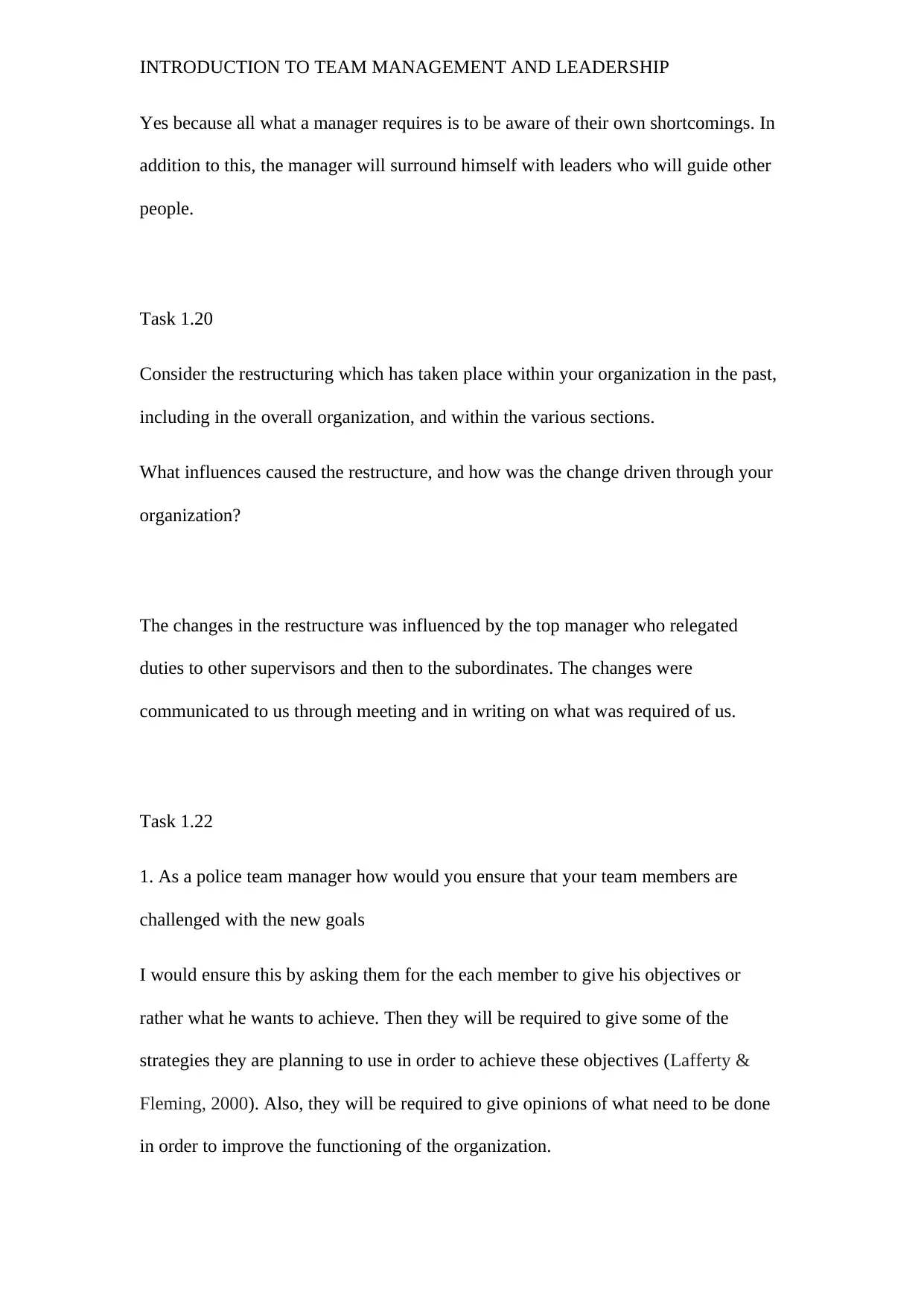
INTRODUCTION TO TEAM MANAGEMENT AND LEADERSHIP
Yes because all what a manager requires is to be aware of their own shortcomings. In
addition to this, the manager will surround himself with leaders who will guide other
people.
Task 1.20
Consider the restructuring which has taken place within your organization in the past,
including in the overall organization, and within the various sections.
What influences caused the restructure, and how was the change driven through your
organization?
The changes in the restructure was influenced by the top manager who relegated
duties to other supervisors and then to the subordinates. The changes were
communicated to us through meeting and in writing on what was required of us.
Task 1.22
1. As a police team manager how would you ensure that your team members are
challenged with the new goals
I would ensure this by asking them for the each member to give his objectives or
rather what he wants to achieve. Then they will be required to give some of the
strategies they are planning to use in order to achieve these objectives (Lafferty &
Fleming, 2000). Also, they will be required to give opinions of what need to be done
in order to improve the functioning of the organization.
Yes because all what a manager requires is to be aware of their own shortcomings. In
addition to this, the manager will surround himself with leaders who will guide other
people.
Task 1.20
Consider the restructuring which has taken place within your organization in the past,
including in the overall organization, and within the various sections.
What influences caused the restructure, and how was the change driven through your
organization?
The changes in the restructure was influenced by the top manager who relegated
duties to other supervisors and then to the subordinates. The changes were
communicated to us through meeting and in writing on what was required of us.
Task 1.22
1. As a police team manager how would you ensure that your team members are
challenged with the new goals
I would ensure this by asking them for the each member to give his objectives or
rather what he wants to achieve. Then they will be required to give some of the
strategies they are planning to use in order to achieve these objectives (Lafferty &
Fleming, 2000). Also, they will be required to give opinions of what need to be done
in order to improve the functioning of the organization.
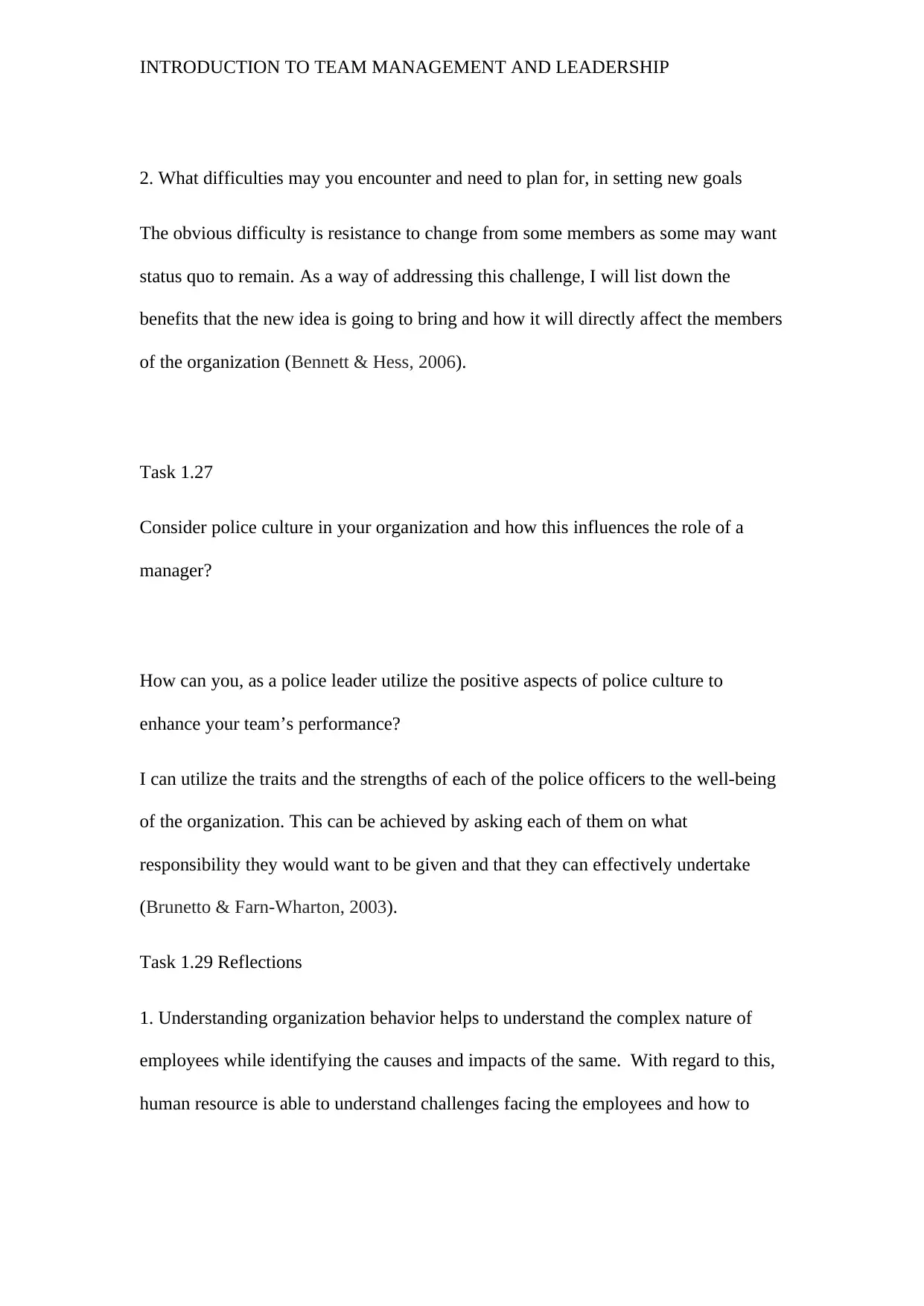
INTRODUCTION TO TEAM MANAGEMENT AND LEADERSHIP
2. What difficulties may you encounter and need to plan for, in setting new goals
The obvious difficulty is resistance to change from some members as some may want
status quo to remain. As a way of addressing this challenge, I will list down the
benefits that the new idea is going to bring and how it will directly affect the members
of the organization (Bennett & Hess, 2006).
Task 1.27
Consider police culture in your organization and how this influences the role of a
manager?
How can you, as a police leader utilize the positive aspects of police culture to
enhance your team’s performance?
I can utilize the traits and the strengths of each of the police officers to the well-being
of the organization. This can be achieved by asking each of them on what
responsibility they would want to be given and that they can effectively undertake
(Brunetto & Farn-Wharton, 2003).
Task 1.29 Reflections
1. Understanding organization behavior helps to understand the complex nature of
employees while identifying the causes and impacts of the same. With regard to this,
human resource is able to understand challenges facing the employees and how to
2. What difficulties may you encounter and need to plan for, in setting new goals
The obvious difficulty is resistance to change from some members as some may want
status quo to remain. As a way of addressing this challenge, I will list down the
benefits that the new idea is going to bring and how it will directly affect the members
of the organization (Bennett & Hess, 2006).
Task 1.27
Consider police culture in your organization and how this influences the role of a
manager?
How can you, as a police leader utilize the positive aspects of police culture to
enhance your team’s performance?
I can utilize the traits and the strengths of each of the police officers to the well-being
of the organization. This can be achieved by asking each of them on what
responsibility they would want to be given and that they can effectively undertake
(Brunetto & Farn-Wharton, 2003).
Task 1.29 Reflections
1. Understanding organization behavior helps to understand the complex nature of
employees while identifying the causes and impacts of the same. With regard to this,
human resource is able to understand challenges facing the employees and how to
⊘ This is a preview!⊘
Do you want full access?
Subscribe today to unlock all pages.

Trusted by 1+ million students worldwide
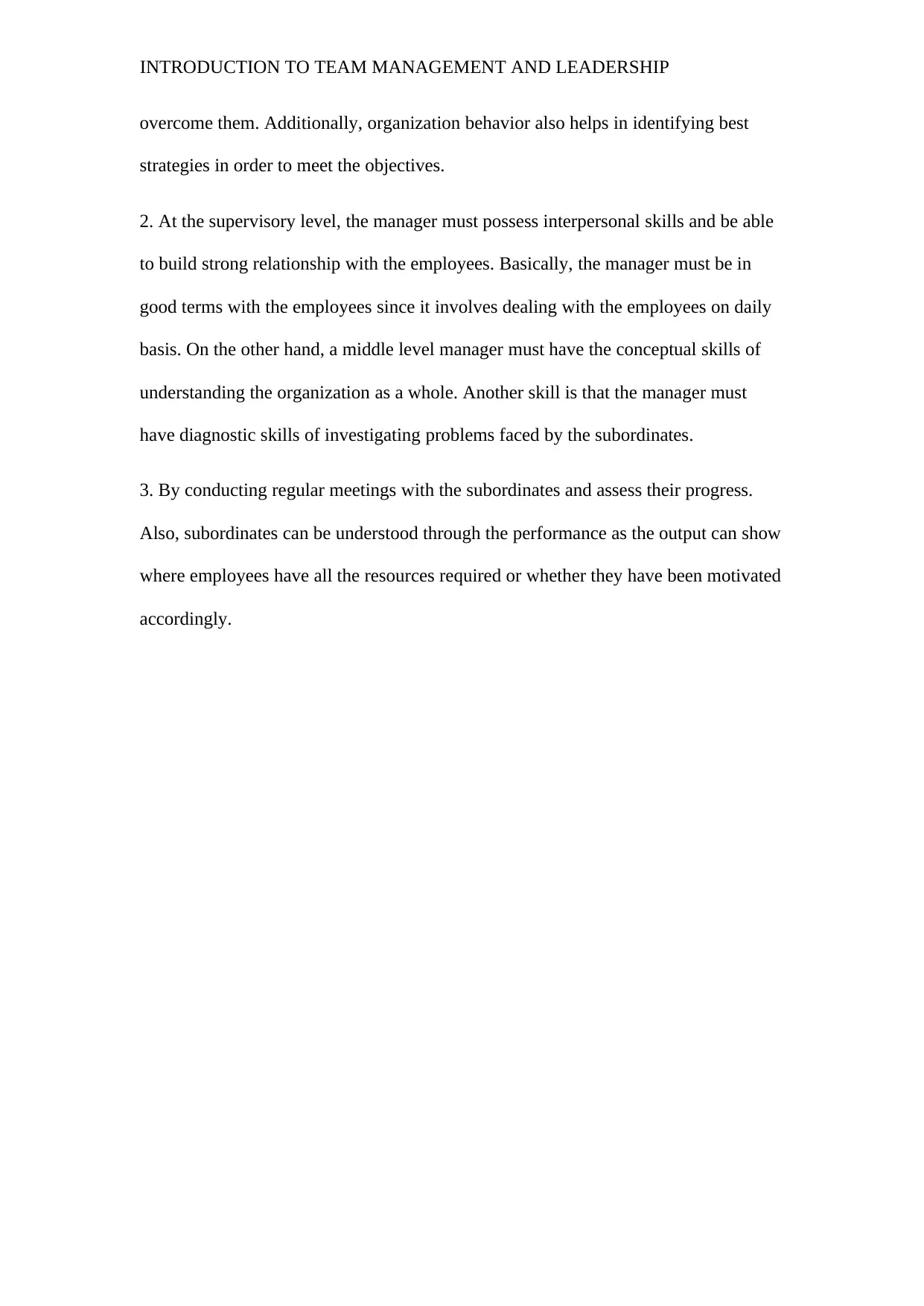
INTRODUCTION TO TEAM MANAGEMENT AND LEADERSHIP
overcome them. Additionally, organization behavior also helps in identifying best
strategies in order to meet the objectives.
2. At the supervisory level, the manager must possess interpersonal skills and be able
to build strong relationship with the employees. Basically, the manager must be in
good terms with the employees since it involves dealing with the employees on daily
basis. On the other hand, a middle level manager must have the conceptual skills of
understanding the organization as a whole. Another skill is that the manager must
have diagnostic skills of investigating problems faced by the subordinates.
3. By conducting regular meetings with the subordinates and assess their progress.
Also, subordinates can be understood through the performance as the output can show
where employees have all the resources required or whether they have been motivated
accordingly.
overcome them. Additionally, organization behavior also helps in identifying best
strategies in order to meet the objectives.
2. At the supervisory level, the manager must possess interpersonal skills and be able
to build strong relationship with the employees. Basically, the manager must be in
good terms with the employees since it involves dealing with the employees on daily
basis. On the other hand, a middle level manager must have the conceptual skills of
understanding the organization as a whole. Another skill is that the manager must
have diagnostic skills of investigating problems faced by the subordinates.
3. By conducting regular meetings with the subordinates and assess their progress.
Also, subordinates can be understood through the performance as the output can show
where employees have all the resources required or whether they have been motivated
accordingly.
Paraphrase This Document
Need a fresh take? Get an instant paraphrase of this document with our AI Paraphraser
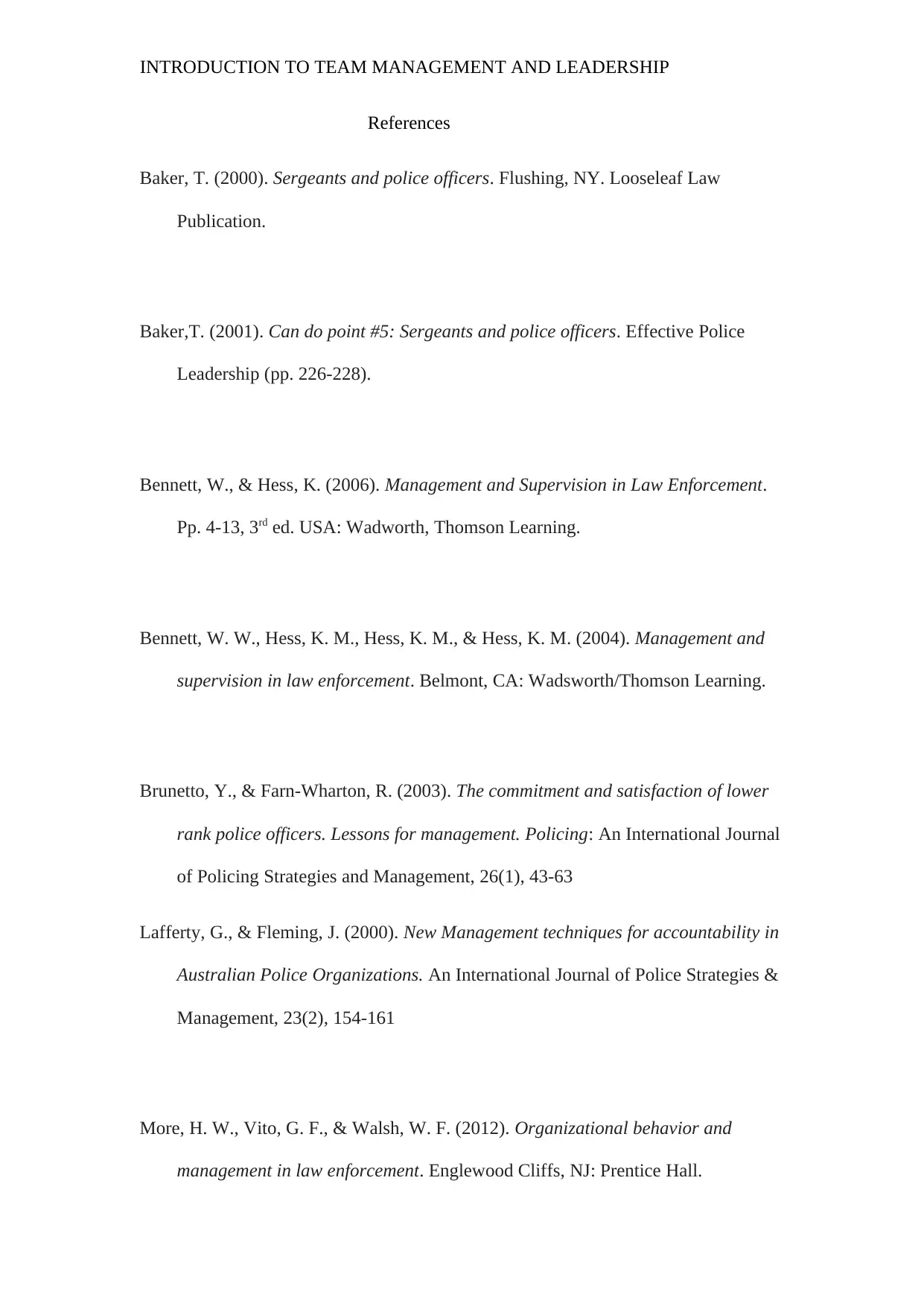
INTRODUCTION TO TEAM MANAGEMENT AND LEADERSHIP
References
Baker, T. (2000). Sergeants and police officers. Flushing, NY. Looseleaf Law
Publication.
Baker,T. (2001). Can do point #5: Sergeants and police officers. Effective Police
Leadership (pp. 226-228).
Bennett, W., & Hess, K. (2006). Management and Supervision in Law Enforcement.
Pp. 4-13, 3rd ed. USA: Wadworth, Thomson Learning.
Bennett, W. W., Hess, K. M., Hess, K. M., & Hess, K. M. (2004). Management and
supervision in law enforcement. Belmont, CA: Wadsworth/Thomson Learning.
Brunetto, Y., & Farn-Wharton, R. (2003). The commitment and satisfaction of lower
rank police officers. Lessons for management. Policing: An International Journal
of Policing Strategies and Management, 26(1), 43-63
Lafferty, G., & Fleming, J. (2000). New Management techniques for accountability in
Australian Police Organizations. An International Journal of Police Strategies &
Management, 23(2), 154-161
More, H. W., Vito, G. F., & Walsh, W. F. (2012). Organizational behavior and
management in law enforcement. Englewood Cliffs, NJ: Prentice Hall.
References
Baker, T. (2000). Sergeants and police officers. Flushing, NY. Looseleaf Law
Publication.
Baker,T. (2001). Can do point #5: Sergeants and police officers. Effective Police
Leadership (pp. 226-228).
Bennett, W., & Hess, K. (2006). Management and Supervision in Law Enforcement.
Pp. 4-13, 3rd ed. USA: Wadworth, Thomson Learning.
Bennett, W. W., Hess, K. M., Hess, K. M., & Hess, K. M. (2004). Management and
supervision in law enforcement. Belmont, CA: Wadsworth/Thomson Learning.
Brunetto, Y., & Farn-Wharton, R. (2003). The commitment and satisfaction of lower
rank police officers. Lessons for management. Policing: An International Journal
of Policing Strategies and Management, 26(1), 43-63
Lafferty, G., & Fleming, J. (2000). New Management techniques for accountability in
Australian Police Organizations. An International Journal of Police Strategies &
Management, 23(2), 154-161
More, H. W., Vito, G. F., & Walsh, W. F. (2012). Organizational behavior and
management in law enforcement. Englewood Cliffs, NJ: Prentice Hall.
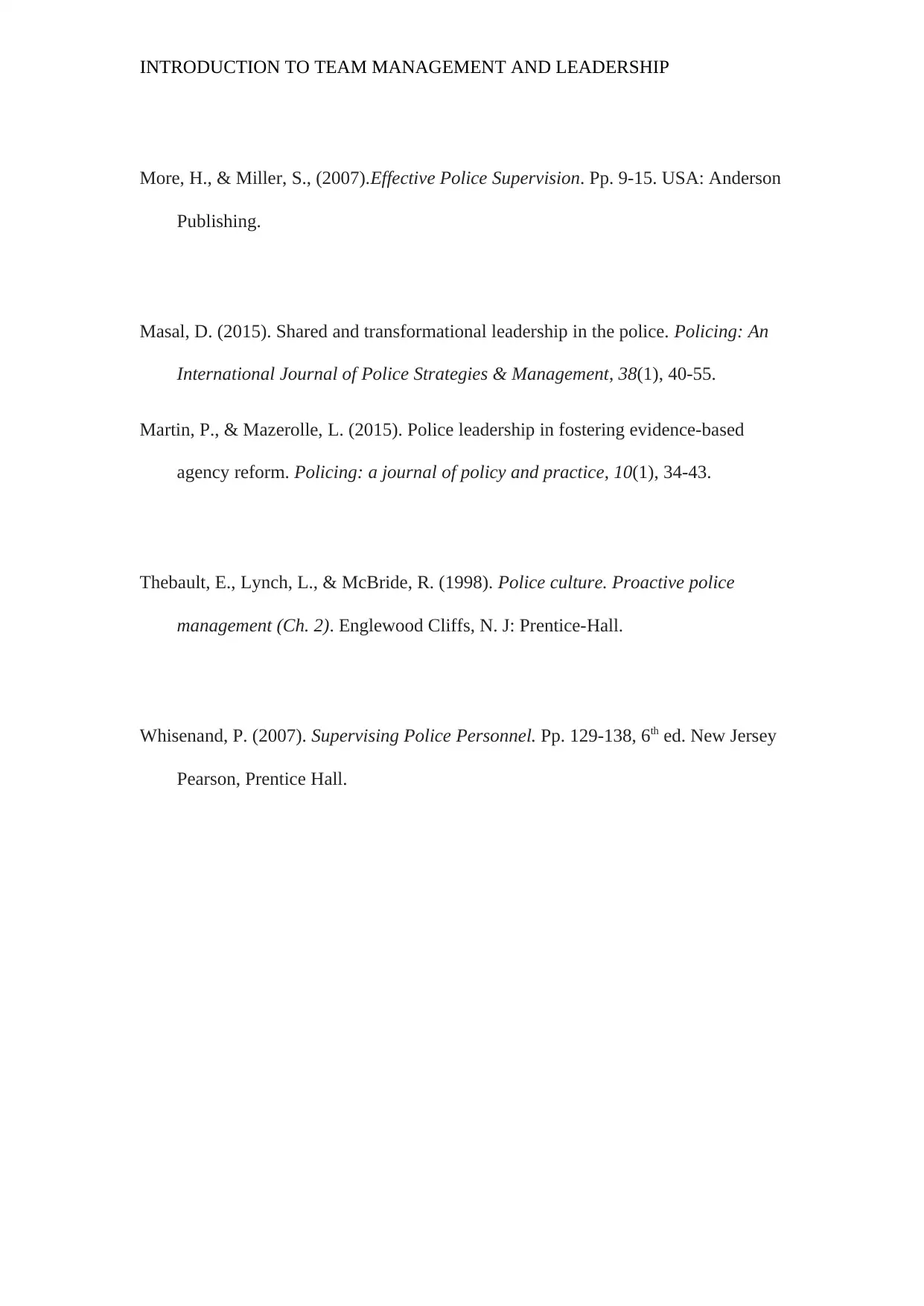
INTRODUCTION TO TEAM MANAGEMENT AND LEADERSHIP
More, H., & Miller, S., (2007).Effective Police Supervision. Pp. 9-15. USA: Anderson
Publishing.
Masal, D. (2015). Shared and transformational leadership in the police. Policing: An
International Journal of Police Strategies & Management, 38(1), 40-55.
Martin, P., & Mazerolle, L. (2015). Police leadership in fostering evidence-based
agency reform. Policing: a journal of policy and practice, 10(1), 34-43.
Thebault, E., Lynch, L., & McBride, R. (1998). Police culture. Proactive police
management (Ch. 2). Englewood Cliffs, N. J: Prentice-Hall.
Whisenand, P. (2007). Supervising Police Personnel. Pp. 129-138, 6th ed. New Jersey
Pearson, Prentice Hall.
More, H., & Miller, S., (2007).Effective Police Supervision. Pp. 9-15. USA: Anderson
Publishing.
Masal, D. (2015). Shared and transformational leadership in the police. Policing: An
International Journal of Police Strategies & Management, 38(1), 40-55.
Martin, P., & Mazerolle, L. (2015). Police leadership in fostering evidence-based
agency reform. Policing: a journal of policy and practice, 10(1), 34-43.
Thebault, E., Lynch, L., & McBride, R. (1998). Police culture. Proactive police
management (Ch. 2). Englewood Cliffs, N. J: Prentice-Hall.
Whisenand, P. (2007). Supervising Police Personnel. Pp. 129-138, 6th ed. New Jersey
Pearson, Prentice Hall.
⊘ This is a preview!⊘
Do you want full access?
Subscribe today to unlock all pages.

Trusted by 1+ million students worldwide
1 out of 12
Related Documents
Your All-in-One AI-Powered Toolkit for Academic Success.
+13062052269
info@desklib.com
Available 24*7 on WhatsApp / Email
![[object Object]](/_next/static/media/star-bottom.7253800d.svg)
Unlock your academic potential
Copyright © 2020–2025 A2Z Services. All Rights Reserved. Developed and managed by ZUCOL.





